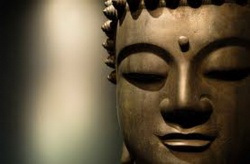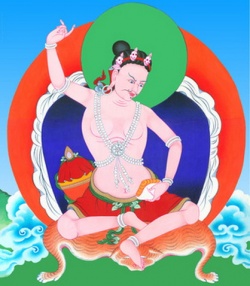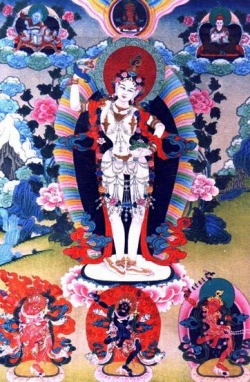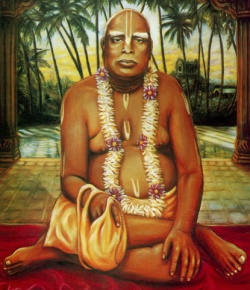A Difference that Makes a Difference: Prasangika Madhyamaka and Sophia Perennis
What I’m going to attempt to do here is to sketch out what I believe is the major philosophical and practical difference between Buddhist Madhyamaka (Middle Way philosophy) and that of a school of thought that has greatly influenced me for three decades, Sophia Perennis, sometimes called Perennialism. I’m going to attempt to present the basic difference between a certain aspect of these two philosophies’ views of reality at a very high level. So I am going to have to forego a lot of distinctions that could make this much more precise. I want to make this exposition accessible to the average person with an orientation toward philosophy and spiritualilty. But I hope not to distort either philosophy in the process. I also think that if you are at all philosophically and spiritually-minded, I can show you very clearly how this difference can have a profound affect on your spiritual life. I think I can show you that these are matters of great practical importance.
Sophia Perennis is based partially on the idea of Platonic Realism. Basically the assertion of Sophia Perennis is that there are real, objective qualities and essences such as The Good, The True, and The Beautiful. But according to Plato’s philosophy, those real qualities don’t exist unequivocally in things themselves. They exist in a pure form, only in a world that is transcendent of our ordinary world.
Then Plato’s philosophy says that these transcendent Forms or Ideas are embodied in an attenuated way in ordinary, particular things through a mode that is translated ‘Participation’. Briefly, what this means is that phenomena bear some analogy to the transcendent essences. They are symbols, if you will, of the transcendent qualities that exist purely in the World of Ideas for Plato. Later, Christian philosophers like St. Augustine and St. Justin the Martyr and others took Platonism into Christianity and said that the transcendent Ideas or Essences were thoughts in the mind of God.
Probably the main reason that Plato and Sophia Perennis postulate the existence of such real essences is because they think it is the only way to account for any real Knowledge. They reflect that everything in the ordinary world perceived by the senses is never stable. Things are in a constant state of flux or Becoming. Thus the rational faculty can never get a permanent grip on things in order to know them. The particulars of everyday experience are always slipping through the fingers, as it were, of any attempt to fix them and know them. So Plato and those who followed him felt it was necessary that there should be qualities or essences that were fixed, permanent and eternal. They thought that the only true Knowledge (Gr. Noesis) was knowledge of these eternal, transcendent essences.
Now Prasangika Madhyamaka refutes that there are real, objective, permanent, or inherently existing essences or qualities, either in things themselves or separate from them. Prasangika Madhyamaka does not try to establish a theory about how things are or are not. Their methodology is not based on speculative considerations of what must be the case in order to account for knowledge or some other aspect of our experience. Buddhist philosophy is different from western philosophy in this way. Western philosophy is usually speculation. That is, it forms a theory and postulates this or that entity or idea as a way to explain or make sense of some aspect of experience or to complete a logical argument.
But the Buddha’s teaching was much more grounded in direct experience and eschewed theoretical speculation. Instead the Buddha asked his followers to investigate their own experience and phenomena more directly. So for instance, in deciding whether there are any essences in things, the Buddhist Prasangika will analyze the phenomena in question looking for the essence of the thing. The classical example was a chariot. The modern equivalent is an automobile. So the Prasangika says, “Take away the wheels. Is it still an automobile? Take away the body parts. Is it still an automobile? Take away the motor. Is it still an automobile?” At some point, everyone in his right mind is going to say that it is no longer an automobile.
If the person claims the essence of the automobile is in that part, which when removed, removes the automobile, then the Prasangika will investigate that part in the same way, looking directly for the automobile. But when he fails to find the automobile, the strict, Prasangika will not make a positive assertion to the effect that there is no automobile. He will simply meditate on this non-finding. He will not form a conceptual or speculative theory. Not all readers will be convinced, of course, by this cursory explanation. There are other paths this way takes in order to cover all the possibilities. But my purpose here is only to show by example the difference of procedure between Buddhist and western philosophy.
But what practical difference does it make whether there are or are not any real qualities or essences in things? It makes a great deal of difference, as I shall show. In Buddhism we say that the method is based on the view. Adherents of Sophia Perennis have a similar conviction in that they teach that, for the type of person for whom Sophia Perenis is intended, the study of pure metaphysics, or the nature of Reality, is necessary, or at least helpful, if not indispensable, in order to gain realization of that Reality. I shall show how the difference of views on whether there are any real qualities conditions a very different orientation toward life and spirituality.
An adherent of Sophia Perennis believes that the view of real objective, transcendent Qualities is a fixed, real, permanent, eternal basis for making judgments. He believes, in fact, that it is this fact which distinguishes his philosophy from all those forms of modern relativism which have no basis for making any objectively, grounded judgments, or indeed have no basis, in his view, for any real, stable, and certain Knowledge whatsoever. On this basis, the adherent of Sophia Perennis can be, and often is, very critical of tendencies, ideas, and even people that in his view depart too greatly from the perfection of the transcendent Qualities. Of course he will admit that nothing in this world can be Perfect.
Only the transcendent essences are Pure and Perfect. So the adherent of Sophia Perennis has a great tendency explicitly to see this world as relatively dark, imperfect and wanting from the point of view of the transcendent Qualities. I don’t wish to say that Sophia Perennis sees the world as unequivocally Evil. But it definitely teaches that the manifest world has within it an ineluctable tendency toward non-Being or Evil – an asymptotic tendency – that is, one that can never be completely realized on pain of complete non-existence. But one doesn’t have to see the world as pure Evil in order to have a negative attitude toward it especially in modern times, which the adherent of Sophia Perennis sees as a period of extreme degradation and inferior manifestations.
Perhaps adherents of Sophia Perennis will substantially agree with my admittedly sketchy portrayal of their views up to this point. They will perhaps say that it is Good and Right thus to make objective judgments and too see Error and degradation for what it really is. They might claim that it is the prerogative of those who are in possession of the keys to objective Knowledge to be critical, on that basis, of ideas, tendencies, and even, perhaps, people objectively in Error. I am not denying that there is value in the view of Sophia Perennis for certain people. But at a certain point in the spiritual path, or for certain other people, this point of view becomes an obstacle, as I shall endeavor to show. Lama Tenpa Gyaltsen recently said, “When you don’t give up an antidote at the proper time, it becomes poison.”
Buddhism does not postulate an all-powerful, creator-God with a transcendent dimension that does not depend on the universe. Neither does it place supreme value in a world transcendent of this one. There are many different views or levels of teaching within Buddhism. But as far as I know, what I have stated is held in common by all Buddhist schools. Although some of the lower schools of Buddhism (as schematized by the Tibetans) do not hold the views I am about to state now, these views are held by Madhyamikas. In the Madhyamaka view, phenomena, including sentient beings, do not have any findable, permanent, or inherently existing essences or Selves either separate from or in phenomena themselves. Madhyamikas just don’t find these kinds of essences when they analyze phenomena looking for them.
Well, an adherent of Sophia Perennis may say, then how does a Madhyamika deal with the problem of how to account for certain, stable Knowledge. If you don’t have any entities that are permanent, stable and Real, then how will you ever really know anything? The Buddha divided all truths into Ultimate Truths and Conventional Truths (The Two Truths). In Prasangika Madhyamika, which is considered the highest schools by most Tibetan lamas, Conventional Truth is just what the consensus of the world says it is. The Buddha said he did not argue with what the world said.
The Prasangikas just leave the conventional realm of what an adherent of Sophia Perennis would call Becoming to the world to determine. Ultimate Truth, on the other hand, does not have recourse to a speculated, transcendent realm but is the truth of essencelessness or No-Self (Skt. Anatman) discovered by analyzing the ordinary phenomena as determined by Conventional Truth. The two truths have a common basis, the world of phenomena and persons. They are not distinguished by their objects but by different ways of looking at the same objects. The problem of stable Knowledge just does not arise for the Madhyamika the way it does for an adherent of Sophia Perennis. A realized Madhyamika is not troubled by the fact that reality is rootless and groundless. (see my post “Buddhist Relativism” for further discussion of this point) In fact he sees such a realization as the only basis for thorough liberation from suffering. Let me try to explain how.
The Buddha taught that it is not phenomena as such nor the world and its objects as such that make us suffer. Here, a distinction is made between suffering and pain. Pain is inevitable in a world such as ours. But suffering is something the mind adds to experience which is not really there. Either we overestimate the good qualities of an object or person and desire it or we exaggerate the bad qualities and so hate it or have aversion to it. These are two of the three roots of suffering according to the Buddha. These two roots come from a misunderstanding of the nature of reality that projects qualities onto objects that they don’t possess. The distortion of the qualities of objects and persons emanates from the profound belief that these qualities and objects exist in and of themselves without depending on anything outside themselves such as causes and condtions. The Madhyamaka teaches that all phenomena are dependent on causes and conditions and, therefore are not independently existent. They are all interdependent. And there is, again, no transcendent realm of independent entities over and above phenomena.
The Buddha’s teaching is that it is our faulty judgments about things are based on the innate view of an independently existing Self (whether it be one’s own individual self or the Absolute Self of various Indian philosophies such as Advaita Vedanta; see “Note on Advaita Vedanta” in a separate post for more on this) either of persons or other objects, or both depending on the school, that is the root cause of all our suffering.
We are enabled to give up these judgments by realizing, on the path, that they are groundless and baseless. Phenomena don’t exist as they appear to do. There are many different levels and ways of approaching realization in the teachings of the Buddha. Many different methods are given to suit the capacities and interests of sentient beings. But I wish to discuss a particular approach that is found in Zen, Vajrayana (Tantra), Dzogchen, and Mahamudra (and perhaps others that I have not mentioned). This is the approach of unconditional acceptance.
In this approach, we seek to give up our resistance to everything that we find unacceptable in ourselves, others, and the world around us. We seek to embrace everything in compassionate acceptance. You have probably heard the saying, “What we resist persists.” According to the insight of the Buddha, the negative judgments (positive ones too) we make about things cause us to tighten up and resist the flow of life. In fact these negative judgments actually lock the false view of a self into place. As long as I am disapproving of something and resisting it, as long as I am trying to improve myself instead of accepting myself as I am, I will always have [the illusion of] a self to disapprove or to improve.
The method of which I am speaking counsels us to let go completely and relax in whatever manifests. We don’t need to beat ourselves up, discipline ourselves, criticize ourselves and others, force ourselves to do or not do anything. All we have to do is let be in compassionate acceptance. This approach releases us from conditioned, dualistic patterns of suffering that cannot be released any other way. What we are trying to do is release the dualistic tension between ourselves and the circumstances of our lives, which everyone can attest often manifest differently from what we would otherwise wish.
This way of compassionate acceptance is made possible by the view that nothing has any intrinsic essence of goodness or badness. We can thus gradually gain the realization that our conditioned thoughts of judgment of ourselves, others, and objects do not really mean what they purport. There is nothing in our thoughts that can intrinsically bind us. Ultimately, they just don’t mean anything.
So, we can detach, listen to them, watch them, but we don’t have to believe what they say. For instance if I have the habitual thought that I am inferior to others, I don’t have to believe it any more because I know that neither myself nor others really, truly exist. (Of course we exist in the conventional truth; that is not at issue here. No Buddhist school is saying that things don’t exist at all. Its just that they don’t exist independently and on their own power or from their own side.). This is the liberation from suffering that Buddhism engenders.
Now, I’m not going to claim that an adherent of Sophia Perennis could never come to this path of compassionate acceptance through his own philosophy. But I do think it would be very much more difficult. I’m open to the idea that its just a matter of different types of people with different psychological and spiritual make-ups and perhaps different destinies. I just know that, for me the idea of permanent, really existing, eternal entities in the heavens was an insurmountable block to the methodology and experience of unconditional acceptance.
Whilst I believed Sophia Perennis, I thought it was my duty to criticize myself, look for my faults, and do my utmost to resist and counter them to the utmost of my capacity. I no longer believe and practice that way. In fact for me, I see it now as a method that led to much unhappiness and suffering. And I had to discard Sophia Perennis in order to take up the way of compassionate acceptance in earnest.
Perhaps its possible, on the basis of belief in the grace of God, for a Christian adherent of Sophia Perennis to come to complete and permanent assurance of acceptance and to transcend the tendency toward debilitating guilt that I found on that path. I just know it didn’t work for me.
The Buddha taught, and I am certain Sophia Perennis agrees, that all conceptual teachings are just so many rafts to get us to the other shore of Enlightenment. After they have served their purpose, they should be discarded. So although I have been at pains to distinguish the differences between these rafts, in the end, there is nothing to grasp and nothing to discard.





